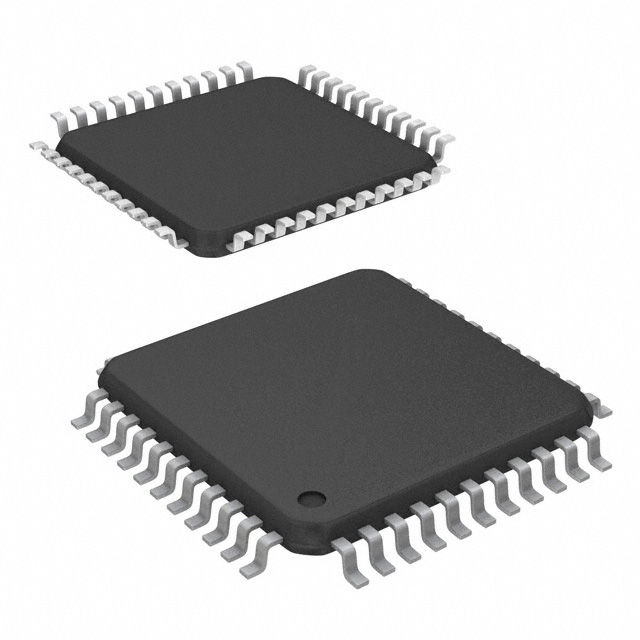Xem thông số kỹ thuật để biết chi tiết sản phẩm.

ATMEGA16A-AU
Product Overview
- Category: Microcontroller
- Use: Embedded systems, robotics, automation
- Characteristics: High-performance, low-power, 8-bit AVR microcontroller
- Package: TQFP (Thin Quad Flat Package)
- Essence: ATMEGA16A-AU is a versatile microcontroller that offers a wide range of features and capabilities for various applications.
- Packaging/Quantity: Available in tape and reel packaging, with a quantity of 2500 units per reel.
Specifications
- Architecture: 8-bit AVR
- Flash Memory: 16KB
- RAM: 1KB
- EEPROM: 512 bytes
- Operating Voltage: 2.7V to 5.5V
- Operating Frequency: Up to 16MHz
- Digital I/O Pins: 32
- Analog Input Channels: 8
- Communication Interfaces: UART, SPI, I2C
- Timers/Counters: 3
- PWM Channels: 4
- ADC Resolution: 10-bit
- Operating Temperature Range: -40°C to +85°C
Pin Configuration
The ATMEGA16A-AU microcontroller has a total of 44 pins, which are assigned different functions based on their configuration. The pinout diagram below illustrates the detailed pin configuration:

Functional Features
- High Performance: The ATMEGA16A-AU offers a powerful 8-bit AVR architecture, allowing for efficient execution of complex tasks.
- Low Power Consumption: With its advanced power-saving techniques, this microcontroller ensures optimal energy efficiency.
- Versatility: It provides a wide range of communication interfaces and peripherals, making it suitable for diverse applications.
- Robustness: The ATMEGA16A-AU is designed to withstand harsh operating conditions, with a wide temperature range and robust packaging.
Advantages
- Cost-effective: The ATMEGA16A-AU offers a great balance between performance and cost, making it an economical choice for many projects.
- Ease of Use: Its user-friendly development tools and extensive documentation simplify the design and programming process.
- Wide Application Range: This microcontroller can be used in various fields, including industrial automation, consumer electronics, and automotive systems.
Disadvantages
- Limited Memory: The 16KB flash memory may be insufficient for complex applications that require large code storage.
- Lack of Floating-Point Unit (FPU): The absence of an FPU limits the microcontroller's ability to perform complex mathematical operations efficiently.
Working Principles
The ATMEGA16A-AU operates based on the AVR architecture, which utilizes a Harvard architecture with separate program and data memories. It executes instructions fetched from the flash memory and stores data in the RAM. The microcontroller communicates with external devices through its various communication interfaces, such as UART, SPI, and I2C.
Detailed Application Field Plans
The ATMEGA16A-AU finds applications in a wide range of fields, including:
- Embedded Systems: It is commonly used in embedded systems for controlling and monitoring various devices and sensors.
- Robotics: The microcontroller provides the necessary processing power and I/O capabilities for robotics applications, enabling precise control and interaction.
- Automation: In industrial automation, the ATMEGA16A-AU can be employed to control machinery, monitor processes, and interface with other systems.
- Consumer Electronics: It is utilized in consumer electronic devices like home appliances, gaming consoles, and remote controls.
- Automotive Systems: The microcontroller can be integrated into automotive systems for functions such as engine control, dashboard displays, and safety features.
Detailed and Complete Alternative Models
- ATMEGA32A-AU
- ATMEGA64A-AU
- ATMEGA128A-AU
- ATMEGA2560-AU
These alternative models offer varying memory sizes, additional features, and increased processing power, catering to different project requirements.
In conclusion, the ATMEGA16A-AU is a versatile microcontroller that combines high performance, low power consumption, and a wide range of features. Its cost-effectiveness and ease of use make it a popular choice in various applications, from embedded systems to robotics and automation. While it has limitations in terms of memory and lack of an FPU, alternative models provide options for projects with higher demands.
Liệt kê 10 câu hỏi và câu trả lời thường gặp liên quan đến ứng dụng ATMEGA16A-AU trong giải pháp kỹ thuật
Sure! Here are 10 common questions and answers related to the application of ATMEGA16A-AU in technical solutions:
Q: What is ATMEGA16A-AU? A: ATMEGA16A-AU is a microcontroller from the AVR family, manufactured by Microchip Technology. It offers 16KB of flash memory, 1KB of SRAM, and various peripherals.
Q: What are the key features of ATMEGA16A-AU? A: Some key features of ATMEGA16A-AU include 16MHz clock speed, 32 general-purpose I/O pins, 8-channel 10-bit ADC, UART, SPI, I2C, timers, and PWM outputs.
Q: What applications can ATMEGA16A-AU be used for? A: ATMEGA16A-AU can be used in a wide range of applications such as industrial automation, robotics, home automation, consumer electronics, IoT devices, and more.
Q: How do I program ATMEGA16A-AU? A: ATMEGA16A-AU can be programmed using various programming languages like C or assembly. You can use an ISP programmer or a development board with built-in programming capabilities.
Q: Can ATMEGA16A-AU communicate with other devices? A: Yes, ATMEGA16A-AU supports various communication protocols like UART, SPI, and I2C, allowing it to communicate with other devices such as sensors, displays, and modules.
Q: What is the maximum voltage that ATMEGA16A-AU can handle? A: The maximum operating voltage for ATMEGA16A-AU is typically 5.5V. However, it is recommended to check the datasheet for specific voltage specifications.
Q: Can ATMEGA16A-AU be used in battery-powered applications? A: Yes, ATMEGA16A-AU can be used in battery-powered applications as it has low power consumption features like sleep modes and power-saving techniques.
Q: Is ATMEGA16A-AU suitable for real-time applications? A: While ATMEGA16A-AU is not specifically designed for real-time applications, it can handle many real-time tasks with its fast clock speed and hardware timers.
Q: Can I use ATMEGA16A-AU with Arduino IDE? A: Yes, you can use ATMEGA16A-AU with Arduino IDE by selecting the appropriate board and configuring the necessary settings.
Q: Are there any development boards available for ATMEGA16A-AU? A: Yes, there are several development boards available that feature ATMEGA16A-AU, such as Arduino Mega, AVR Dragon, and various custom-made boards.
Please note that these answers are general and may vary depending on specific requirements and use cases.

